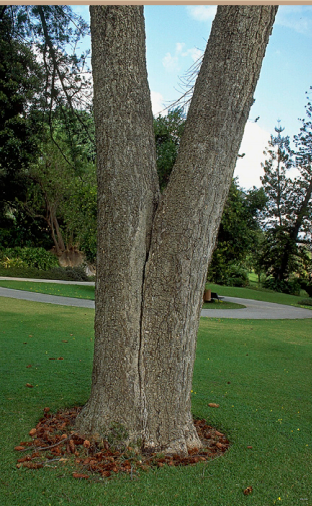You should inspect healthy and unhealthy trees on a regular basis. Although some tree failures are not predictable and cannot be prevented, many failures can be prevented. Large trees have a greater hazard potential than small trees and should be inspected more frequently and in greater detail. Always make your inspections from the ground, do not climb the tree or use a ladder to improve your viewing perspective. If you suspect a hazardous condition, immediately contact your utility company and consult an arborist who has the equipment and training to conduct the inspection safely.
Thoroughly inspect the tree for the following defects:
Lean: Determine whether the vertical axis of the tree has recently changed and check the ground around the base of the tree for uplift or exposed roots. If the tree was vertical but has moved from the vertical position, it is called a leaner. These are trees that are in the process of falling and could fall completely at any time and require immediate attention.
Multiple trunks: Some trees develop more than one trunk, which are often weakly attached and prone to splitting apart— especially those with narrow angles of attachment. This condition is a concern in large trees. Inspect the point where the trunks meet.
Weakly attached branches: Inspect large branches (greater than 3 inches) at the point where they attach to the trunk. Trees with many branches arising from the same point on the trunk are weak and potentially hazardous. If one branch breaks, the others are more likely to fail.
Cavities, large decay pockets, and other evidence of decay: Inspect the trunk and large branches for cavities or large decay pockets. If you find cavities or decay where branches meet or at the base of the trunk, they are a concern. If a cavity or decay pocket is especially large and is at a key structural location, the tree is more likely to fail.
Mushrooms and conks growing on the bark of trees or on exposed roots indicate root rot or wood decay. As the decay progresses, the wood is weakened and failure is more likely. Do not attempt to clean out or seal a cavity or decay pocket—you may be doing more harm than good.
Trunk and branch cracks: Inspect the trunk and large branches for cracks. If a crack is found, determine if it extends into the wood or is confined to the bark. Insert a pencil or other object into the crack and measure its depth.
Cracks confined to the bark are not usually a problem, but there is reason for concern when the crack extends into the wood. Deep cracks indicate that a separation of the wood within a trunk or branch has occurred and the tree has become structurally weakened. If you find a crack, it is best to have it inspected by an arborist.
Hanging or broken branches (hangers): Hangers are branches that are broken but have not fallen from the tree. They may still be partially attached or completely separated and lodged in the canopy. Inspect for branches that are hanging down from a break point and for branches that have broken off completely and are resting on other branches. Hangers should be removed as soon as possible.
Dead branches (deadwood): Branches that have died will eventually fall off and can cause damage when they fall. Inspect trees that lose their leaves in winter when they are in full-leaf (late spring through early fall). Evergreen trees can be inspected for deadwood at any time. If you find deadwood, plan to have it removed. This does not have to be done immediately, but should not be ignored.
Obtaining professional advice and services: The best assurance of getting quality advice or tree work is by hiring an arborist certified by the International Society of Arboriculture (ISA) or a consulting arborist who is a member of the American Society of Consulting Arborists (ASCA). Certification does not guarantee quality performance, it is only a means of helping you select an arborist who has a demonstrated level of knowledge and technical proficiency. You should verify that your arborist is insured and check his or her references. When you call for service, the arborist will come out and assess the storm damage to your trees and explain the best way to repair the tree if it is salvageable.
This article was taken from UC IPM publication 8365, Inspecting Your Landscape Trees for Hazards. The full publication can be found here.